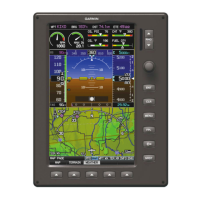190-01115-01 G3X™/G3X Touch™ Avionics Installation Manual
Rev. AV Page 9-2
9.4 Unit Installation
Fabrication of a wiring harness is required. Sound mechanical and electrical methods and practices are
recommended for installation of the GI 260. Refer to Section 2.3
for wiring considerations, and to
Section 23.5
for pinouts.
1. Select a mounting location where the GI 260 is easily visible, but does not impede the pilot’s field
of view, typically the glareshield.
2. If needed, make a hole in the glareshield to run the pigtail harness through.
3. Secure the Socket Mount to a suitable mounting location (glareshield) using (3) #6-32 100º flat
head screws.
4. Insert the GI 260 into the Socket Mount, adjust for best viewing angle.
5. Make connections (Figure 24-1.6
) to the pigtail harness by either splicing wires or adding a D-sub
connector to the end of the pigtail (after it has run through glareshield or mounting surface) and
connect to another D-sub connector on harness.
6. Shields should be continued through any splices by grounding your shield to the spare shield
ground drain wires.
7. If applicable, assemble the connector backshells and connect backshell connectors.
9.5 Unit Calibration
An in-flight AOA calibration is required for GI 260 installations, see Appendix H.4.6.1 and
Appendix H.4.6.2
(for GDU™ 37X display installations) or Section 30.4.9.1 and Section 30.4.9.2 (for
GDU 4XX installations). For GDU 4XX installations, AOA calibration can be completed twice to
compensate for flap position.
9.6 Unit Operation
See Figure 9-2 for AOA display descriptions.
The GI 260 has two buttons below the display labeled as TEST and MUTE. When the TEST button is
pressed, the GI 260 performs a self test. During the self test, all indicators on the display will be
illuminated to signal the unit passes the test. The red chevrons on the display will flash on and off to
indicate a failure. Releasing the TEST button restores normal operation.
Pressing the MUTE button mutes any currently playing audio. The audio will then remain muted until any
Stall Warning (red) or Caution Alert (yellow) conditions have returned to a Minimum Visible (green)
condition. The mute operation is then reset, and audio is unmuted.
Figure 9-2 GI 260 Display
Stall Warning
AOA
Caution Alert
AOA
Approach
Target AOA
Minimum
Visible AOA

